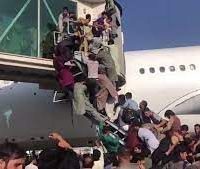
You may not have heard about this, but a few weeks ago, in mid-April, the Taliban scored its deadliest battle victory since the US invasion in 2001. Ten Taliban militants slaughtered at least 144 Afghan Army soldiers and wounded 60+ more, at an Afghan army base just outside of Mazar-i-Sharif in the north of the country.
The attack took place about a week after Trump dropped the largest conventional bomb the US has ever used on an area in eastern Afghanistan. I’m starting to wonder if the MOAB was as much a paranoid, desperate attempt to “send a message” to Russia and Iran as it was meant to kill Islamic State fighters in the area, but I’ll get to that in a minute.
The attack on the Afghan Army base in the north was a turkey shoot: The Afghan Army soldiers were largely unarmed and caught by surprise, just emerging from Friday prayers for lunch on their base, when about half a dozen Taliban militants stormed the base with help from four Taliban plants inside the Afghan Army base. The killing lasted 5 hours. The Taliban say they killed 500, and some witnesses claim many more than 140 were killed. It’s even possible that one or two of the attackers got away.
Everything about this slaughter is bad news if you’re looking at it from the US point of view. The Taliban said the attack was in retaliation for the killings of two of their shadow province leaders in the north of the country—and that, along with the ease with which they carried this out, suggests they could do a lot more of these types of massacres if they felt they needed to. The way the Taliban tells it, the massacre was more like a warning: “Don’t kill our leaders like that—we can fuck you up much worse than you can us.”
You can see in this AFP photo report how bad the attack must’ve been. But it’s details like this that make you realize how much worse it can get—and will get:
They were dressed in Afghan army uniforms, multiple sources have told AFP, fuelling suspicions of complicity on the 30,000-strong base, where Western instructors are sometimes called on as part of NATO’s training, assist and advise mission.
At the second checkpoint one officer became suspicious, the source said — only to have two of the militants trigger their suicide vests, as the rest hurtled past at full speed towards the mosque, roughly a kilometre from the entrance.
They knew the base, the source said, stressing the meticulous preparation involved — four of them had trained there in the past, and all carried valid passes.
They knew that in the part of the base they were headed no soldier was allowed to carry a weapon.

The story out of Afghanistan has been getting worse and worse since at least 2007 if not earlier, and nothing we’ve done—Obama’s Surge, or Obama’s non-withdrawal withdrawal; Britain’s alleged withdrawal in 2014, or Britain’s not-really-withdrawal a year later—seems to work. (Packing up and leaving once and for all is one of those pipe-dream ideas that’s far too obvious for any DC hack to consider “credible.”)
Last year alone, a record 6,800 US-backed Afghan Army soldiers and police were killed, an increase of 35% over 2015. And this year is off to such a bad start that 2016 might be remembered fondly as the peaceful salad days. In just the first two months of this year, during what’s usually the Taliban’s winter recess, 807 Afghan Army soldiers were killed, a figure described as “shockingly high” by the US government’s Special Inspector for Afghanistan Reconstruction (SIGAR).
And then came April’s massacre, the single worst defeat by the US-backed Afghan military since we invaded in 2001—10 Taliban fighters killed or wounded over 200 of our soldiers. That’s about as clear a sign as any that something is seriously, seriously wrong in Afghanistan, in a very familiar and grim way—as in, ARVN-familiar.
Only about half of Afghanistan is still under nominal control of the US-backed regime in Kabul, and that territory keeps shrinking fast. When things go this badly, you need to either accept responsibility for your failures and be held accountable for them—or blame a bogeyman that everyone in your camp is already prepared to believe in? A lot of jobs and contracts are at stake here, along with military careers and promotions. Accepting responsibility and admitting failure is bad for careers, and bad for contractor lobbying. If you want to pump more money out of taxpayers, you can’t admit you’re failing in a lost cause—you need to scare Washington, to make them think they’ll be in trouble if they don’t fork over the public’s money.
As you can guess, finding that bogeyman isn’t exactly rocket science. By now, even your dog knows who to blame: “Russia is sending weapons to Taliban, top U.S. general confirms” reads a Washington Post headline from April 24.
Actually the US general in charge of Afghanistan, John Nicholson, wasn’t quite as committal in that assessment as the WaPo would’ve liked—he said, “We continue to get reports of this [Russian] assistance.” So the WaPo did what all American hacks do today and went straight to their beloved “anonymous US official” for the money quotes and evidence:
A senior U.S. military official, who spoke on the condition of anonymity to discuss intelligence on the issue, said the Russians have increased their supply of equipment and small arms to the Taliban over the past 18 months. The official said the Russians have been sending weapons, including medium and heavy machine guns, to the Taliban under the guise that the materiel would be used to fight the Islamic State in eastern Afghanistan. Instead, the official said, the weapons were showing up in some of Afghanistan’s southern provinces, including Helmand and Kandahar — both areas with little Islamic State presence.
That’s quite an odd, slippery paragraph of damning evidence, considering the sorts of things these anonymous US military/intelligence officials are usually quoted saying. Here, weapons in a country that’s been a war zone and small arms bazaar for four decades show up in the wrong province—and that’s proof of Russian intentions? It may be true, but it sure is bizarrely thin proof to back that claim up.
About a week earlier, the WaPo ran another of these “Russia arming the Taliban” stories that’ve been creeping towards the center of our media narrative about Afghanistan lately. This one was given a headline that reads like a playground taunt:
“While the U.S. wasn’t looking, Russia and Iran began carving out a bigger role in Afghanistan”.
If you actually try making sense of the article, paragraph to paragraph—it makes almost no sense at all. That may be more a reflection of the tangled reality on the ground than anything else—but the point is that the headline and thesis of the article, which is what most people will read and remember, finds no coherent support in the body of the article itself, were anyone to actually read it.
And indeed it makes little sense that Russia would agree to a serious alliance with its old enemy the Taliban—which allied with Chechen Islamist separatists in the late 1990s and early 2000s, harbored and trained them, and which threatened Russia’s closest ally in Central Asia, Tajikistan. It makes perhaps even less sense that Shia Iran— which borders Afghanistan—would ally with a radical sectarian Sunni group like the Taliban, which had waged a brutal sectarian war on the Shia Hazara as well as the Persian-speaking Tajiks.
What does make sense is that both Iran and Russia—which supported the initial US invasion of Afghanistan in 2001, only to see it go from bad to worse—would be actively positioning themselves for the inevitable moment when the US and NATO pull out of Afghanistan for good, and that moment looks like it’s accelerating. The US has had a bad habit of making a mess of countries it “liberates”—then withdrawing in a fit of grievances about how the locals don’t appreciate them, or can’t manage their own affairs, or, as with Libya, out of regret for doing “stupid shit.” Iran and Russia are neighbors of Afghanistan, and logic would tell you that if you lost to the mujahideen in the 1980s, and the West couldn’t defeat them since the turn of the century—then you better start finding ways to work with them, because chances are you’re going to be stuck with them one way or another.
This explains why both Russia and the Taliban have admitted to holding talks about a political solution. Some on the Russian side have said publicly they think they can work with the Taliban, that the Taliban has transformed from an internationalist Islamist movement to a purely nationalist movement. That sounds like wishful thinking if they really believe it.
There are other reasons Russia would want to work with the Taliban—worries about the Taliban threatening Tajikistan, again; create problems for US forces there, because defeat in war leaves raw wounds that can last decades; to get some leverage with the Taliban before their inevitable return to power; to get some leverage against the US that can be bargained away later for a deal in Syria or Ukraine, or to end sanctions . . . but the guff about Russia “arming the Taliban” seems like a stretch, and so far hasn’t been supported by evidence, or even with much conviction by the US military.
But screaming about Russians arming and allying with the Taliban helps guys like John McCain and Linsday Graham push for more soldiers in Afghanistan, more budget outlays, more weapons, more New Cold War mongering. There’s nothing subtle about this: McCain and Graham wrote an op-ed in the WaPo calling for more troops in Afghanistan—citing the WaPo article on the alleged Russian-Taliban alliance as proof we need thousands more troops there. Talk about deja vu…
It’s also strange to be floating conspiracies about Russian arms making their way to Kandahar bazaars, when we all know who has been backing the Taliban: the ISI, Pakistan’s intelligence service, with funding from the Saudis and the Gulf monarchies. The ISI nurtured, trained, equipped and advised the Taliban from its birth in Pakistani refugee camps, to its conquest of most of Afghanistan in the mid-late 1990s; and the Saudis and Gulf monarchs sponsored the whole thing. This isn’t a big secret. Just a few months ago, the New York Times did a big exposé headlined “Saudis Bankroll Taliban, Even as King Officially Supports Afghan Government”. But stories like that are just bummers, so everyone willfully forgets it and goes back to its version of Pokémon Go—something like “Putínmon Go” where every DC hack and military contractor runs around virtual-Afghanistan catching virtual-Putínmon phantoms…
There’s also a question about another possible sponsor: Turkmenistan, which borders Afghanistan in the northwest. Before 9/11, Turkmenistan had friendly relations with the Taliban. After 9/11, they saw the writing on the wall and cut off support. But a couple of months ago, Ismail Khan, the warlord who more or less controls Herat, accused Turkmenistan of renewing their old friendly ties with the Taliban—arming the group, giving them refuge and providing cover for their local commanders.
An honest assessment would compare whatever support Russia and Iran have given the Taliban, if at all—to the support given the Taliban by our allies Pakistan and the “moderate” regimes in the Gulf—as well as Turkmenistan, the weirdest regime on earth, and one who we won’t say one bad word about because Turkmenistan hasn’t been friendly with Russians since independence. And as we’ve learned once again, for the umpteenth time, the best way to get the human rights poodles from snapping at your ankles is to snap “Russia!” at their owners, and you’ll get the sort of “sanctions relief” extended to Europe’s last dictator Lukashenko.
The real story here may be a broader realignment going on—with the US moving closer to India to counter China as part of Obama’s half-baked “Asia Pivot”—a realignment that’s pushing Pakistan closer to Russia for the first time. But that’s for another blog post. And I doubt that realignment will come any time soon, even if they’re flirting with it around the edges—the ties between the Pakistan military and intelligence with the US and the UK, and the “moderates” in the Gulf, are far too deep.
I’ll end this with an old Siberian punk song, “Afghanskii Syndrome”—it’s a cover version by the great Egor Letov of a song by another Siberian punk band from Tyumen, from 1990, just after the Soviet withdrawal. A rough translation of the final verse:
What’s it mean to lose a war
It means to be ashamed of medals
It means to return to your homeland
Where they shun you like you’re a cattle rustler
What’s it mean to lose a war
It means to learn how to shoot
It means to return and live like a coiled spring
Having grown used to killing with ease
Mark Ames is co-host of the Radio War Nerd podcast with Gary Brecher (aka John Dolan). Subscribe here.
Read more:, Mark Ames, Russia Blog


Got something to say to us? Then send us a letter.
Want us to stick around? Donate to The eXiled.
Twitter twerps can follow us at twitter.com/exiledonline















10 Comments
Add your own1. Felipe | May 8th, 2017 at 8:47 am
Thanks so much for this blog series. Keep it up!
2. Steve | May 8th, 2017 at 12:26 pm
Great stuff here Mark. Thanks
3. Dan | May 9th, 2017 at 12:51 pm
Lovely post
4. Procopius | May 10th, 2017 at 5:57 am
Don’t we also have an air base in Turkmenistan that is absolutely essential for supplying our troops in Afghanistan?
5. Bruce | May 10th, 2017 at 8:27 am
Time for US’ “empire” to make like a tree and get Teh HELL 0UT !
6. Putins personal apologist | May 10th, 2017 at 10:48 am
Pro Russian propaganda incoming:
As to what actually is going on:
Basically, Russia has a habit of talking with whoever is their enemy most of the time. This is often pretty useful because it allows you to do fun things such as fragmenting opposing coalitions, getting useful information and figuring out where the enemies priorities are. Very useful if you are into Realpolitik and strategy stuff such as trying to engineer a situation where the adversaries centre of attention is disjunct from what is actually important for him.
Sending weaponry to the Taleban, well, it is possible that some of the weaponry that Russia gave or sold to its real Tajik and sometimes Uzbek proxies got creatively reappropriated by some enterprising Afghan middlemen and ended up in Kandahar. This is the most likely explanation.
It is also possible that Russia is trying to stir up inter Taleban paranoia, if some parts of the Taleban get Russian weapons, other parts of the Taleban will wonder precisely whom they sold out for that.
The Taleban are a coalition themselfs, they used to be held together by Mullah Omar (a pretty impressive adversary) and hatred of the invaders. Omar is dead and the Americans will leave, so fragmenting the Taleban coalition can perhaps be achieved. If the Taleban would split into 2-3 factions, well, these individual factions would no longer be strong enough to take the rest of Afghanistan by force of noone intervenes, which would be a neccessary (but not sufficient) requirement for some kind of federalized compromise.
I mean, why would the Taleban compromise if, absent foreign intervenes, they could just take everything by force?
There is also the “learn from big brother USA thing”, the USA established that backing “national Islamists” is OK in Syria and Lybia, and well, the Taleban fit the “National Islamist” label pretty well.
They also arent that impressed with Bagdadi Khalifate credentials.
7. Putins personal apologist | May 10th, 2017 at 4:10 pm
Addendum:
With they I mean the Taleban. They were OK with Al-Quaida because AQs stick was basically being the Islamic foreign legion. AQ did not demand submission of whomever it was assisting, and was thus fairly “welcome” among hard core Sunnis everywhere.
ISIS actually demands fealty to Bagdadi, and thats a bit of a dealbreaker for everyone who either doesnt exactly belief in Caliphs or thinks that the only Caliph is he himself. Which is a considerable proportion of hard core Sunni leadership.
It is also the reason why Russia bombs AQ aligned groups (which are also western backed) in Syria much more then it bombs ISIS, they simply regard them as more dangerous because they are not pretending to be a Caliphate (for example, ISIS would have a kind of hard time to change back into Guerillias, because being a Caliphate means they have to hold territory. Al-Quaida can run and/or hide much more simply).
8. Rehmat | May 14th, 2017 at 6:07 pm
Professor Rajan Menon (University of New York) wrote in September 2016: “Few will say it, but the facts are indisputable: America’s war in Afghanistan has failed. There comes a time when persisting in a lost cause amounts to foolishness, indeed irresponsibility. That time has arrived.”
Pakistan’s top spy, Lt. Gen. Hamid Gul had predicted in 2010 that America’s war in Afghanistan was a lost cause.
American Jewish writer, political commentator, author of seven books, anti-war activist and ex-Zionist Phyllis Bennis claims the US wars in Afghanistan and Iraq were to serve Israeli interests. She also claims that the same Zionists are now pushing America into new war with Iran.
“The US is 11 years into its current war in Afghanistan and still losing. We never had a chance to WIN this war of vengeance – and while few in Washington are ready to admit that, they have continued to revise and redefine what WINNING might look like,” Ms Bennis wrote on April 19, 2012.
https://rehmat1.com/2017/04/27/lobby-us-cant-afford-to-lose-afghanistan-to-taliban/
9. mangafox | December 22nd, 2017 at 2:46 am
Don’t we also have an air base in Turkmenistan that is absolutely essential for supplying our troops in Afghanistan?
10. tank trouble | September 27th, 2018 at 6:46 am
Thanks for Nice and Informative Post.
Leave a Comment
(Open to all. Comments can and will be censored at whim and without warning.)
Subscribe to the comments via RSS Feed